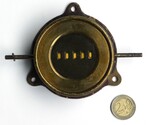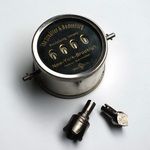

Steam Engine Counter
Video
Portable Counter
Video
History
Articles and Advertisements
Patents
Links
This is a 5-digit revolution counter, very probably made by Schäffer & Budenberg. It is intended for industrial use, and was generally used with steam engines, both locomotives and stationary engines. It is mounted in a round brass case with a small window in the front. An axle goes through it, and each full rotation of the axle increments the counter. The case has a small built-in lock to guard against tampering.
When unlocked, the case hinges open, allowing the counter to be reset. It does not really have a reset mechanism, but the piece to the left of the number wheels can be hinged out of the way, allowing the wheels to be slid apart and rotated independently.
Note that while the case is bare brass, the base of the counter is painted a nice crimson colour. This was common for steam engines, especially in the UK.
The units number wheel is driven from the main axle via a clever eccentric gear mechanism that causes a 10:1 gear reduction, and also causes the units wheel to pause on each number. This is the same mechanism that is used in the carry mechanism of the Dacometer.
The counter has no markings of any kind so it is difficult to confirm when the counter was made and by whom, but it is highly likely to be Schäffer & Budenberg. Its mechanism is essentially identical to that of the S&B counter below. The carry mechanism (and reset method) was patented by Eduard Stalmann, filed in 1879. He was based in Buckau, which is also where S&B was based, and according to a recent book about the company, Eduard Stahlmann was an employee. The mechanism driving the units wheel in his patent can be seen in other S&B counters. I therefore believe that this counter was made by Schäffer & Budenberg, some time between 1880 and maybe 1920.
This is a 4-digit revolution counter, made by Schäffer & Budenberg in germany, but sold in their New York branch. It comes in a nice cloth-lined box, and is provided with two types of connector. This kind of counter was often used in an industrial setting, where the counter measures the production output of a machine. The counter would be mounted such that it could be easily removed and taken to a central point where its counter value could be recorded.
The face of the counter bears the text:
The Schäffer & Budenberg
Manufacturing Company
New-York-Brooklyn
German Manufacture
Trade/mark
In the middle of the word Trademark is a small logo of a pressure gauge.
The mechanism is identical to the other counter.
It does not have a reset mechanism. The bezel can unscrew, allowing the glass and face to be removed, and giving access to the counter mechanism. To the left of the number wheels is a small screwed-down block, and removing that allows the number wheels to be slid apart and reset manually.
The units number wheel is driven from the main axle via a clever eccentric gear mechanism that causes a 10:1 gear reduction, and also causes the units wheel to pause on each number. This is the same mechanism that is used in the carry mechanism of the Dacometer.
It is not possible to precisely date this counter, but I estimate it was made between 1900 and 1920.
Schäffer & Co was founded in 1850 in Magdeburg by the engineer Bernhard Schäffer, the merchant Christian Friedrich Budenberg and others. Within 2 years those others left, and the company name was changed to Schäffer & Budenberg. Schäffer had developed a pressure gauge, patented in 1849, which the company began to manufacture. The company grew and in 1859 relocated to Buckau, on the outskirts Magdeburg, which were larger premises with adjacent land that allowed for future expansion possibilities. Buckau was already home to Maschinenfabrik Buckau R. Wolf, which made steam engines.
The company was very quick to set up subsidiaries in other countries, starting with a workshop in Manchester, UK in 1857. Unfortunately, the First World War had a devastating effect on most of those overseas activities and assets. The Manchester branch was expropriated by the British Crown, severing all ties to the Germany parent company. The company director, Fred Budenberg, was born in England and could stay on to continue running the company. In 1917 Fred was allowed to buy back the company, provided its board members were and remained English born. This company was renamed the Budenburg Gauge Company Ltd., and continues trading to this day.
Schäffer & Budenberg also had a presence in the USA. In 1889 a factory/office building was built in Brooklyn, New York, from which the the Schäffer & Budenberg Mfg. Co. would successfully operate for many years. This too was affected by the War, as the company was seized in 1917 by the Office of Alien Property Custodian. In 1919 it was sold to the American Gauge and Valve Co., under which S&B remained a fairly independent division, keeping its name even though it no longer had any connection to the German former parent company. The American Gauge and Valve Co. was bought by Manning, Maxwell & Moore in 1923, and was renamed the American Schäffer & Budenberg Corporation. In 1928 however, the name was abandoned when the company was merged into another MM&M subsidiary, the Consolidated Ashcroft Hancock Company.
The original Schäffer & Budenberg company in Buckau had been making armour and other items for the military during the war, but returned to normal production afterwards. New products were developed and the company grew to about 3250 people in 1925. Then the Great Depression hit, and the workforce shrank down to just 1100 employees in 1933. The company survived, and with the rise of the Nazi party began to grow and pivot once again towards military production. During the second world war much of the workforce was conscripted, and forced labour was used to replace the lost manpower. The Buckau facilities were badly bombed, and more than half of the buildings were destroyed.
After the war, Magdeburg-Buckau was in the Soviet-controlled sector of Germany, so the company soon changed into an SAG under control of the Soviet administration, and the name Schäffer & Budenberg was no more. Various company names followed, such as Meßgeräte- und Armaturenwerk "Karl Marx", and it became part of a larger combine. After the Berlin wall fell, the Buckau plant continued as Meßgeräte GmbH Magdeburg for a few years, but went into liquidation in 1994.
Included below is an excerpt from Schäffer & Budenberg's 1870 catalog describing their original steam engine counter. It uses the same drive mechanism shown in Stalmann's patent. Later articles and ads show the newer counter with what seems to be the eccentric gear mechanism.
The US patent by Eduard Stalmann in 1879 is for a very similar counter,
differing only in that it has a different mechanism to drive the units
wheel.
The 1892 Swiss patent has an illustration of a counter with an
eccentric gear to drive the units wheel.
| Patent | Filing date | Priority date | Name | Description |
|---|---|---|---|---|
| US 217,827 | 23-04-1879 | 22-07-1879 | Eduard Stalmann | Improvement in Counting-Registers |
| CH 5,185 | 30-06-1892 | 30-06-1892 | James Jaquet | Connection to a counter |
© Copyright 2021-2025 Jaap Scherphuis, mechcalc a t jaapsch d o t net.